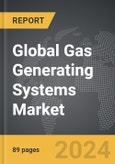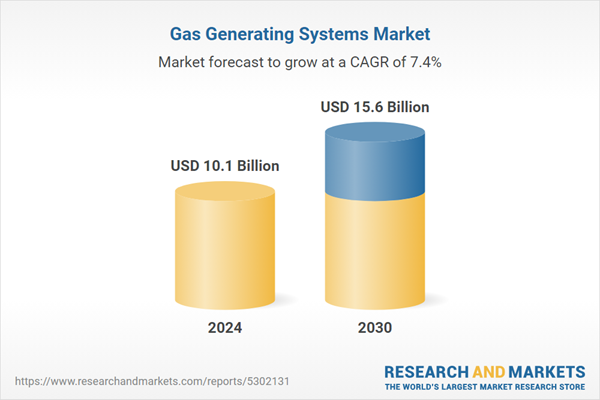The global market for Gas Generating Systems was valued at US$10.1 Billion in 2024 and is projected to reach US$15.6 Billion by 2030, growing at a CAGR of 7.4% over the analysis period 2024-2030. This comprehensive report provides an in-depth analysis of market trends, drivers, and forecasts, helping you make informed business decisions. The report includes the most recent global tariff developments and how they impact the Gas Generating Systems market.
Segments: Segment (Gas Generating Systems).
Geographic Regions/Countries: World; United States; Canada; Japan; China; Europe (France; Germany; Italy; United Kingdom; Spain; Russia; and Rest of Europe); Asia-Pacific (Australia; India; South Korea; and Rest of Asia-Pacific); Latin America (Argentina; Brazil; Mexico; and Rest of Latin America); Middle East (Iran; Israel; Saudi Arabia; United Arab Emirates; and Rest of Middle East); and Africa.
The analysts continuously track trade developments worldwide, drawing insights from leading global economists and over 200 industry and policy institutions, including think tanks, trade organizations, and national economic advisory bodies. This intelligence is integrated into forecasting models to provide timely, data-driven analysis of emerging risks and opportunities.
Global Gas Generating Systems Market - Key Trends and Drivers Summarized
Why Are Gas Generating Systems Essential for Critical Industrial Applications?
Gas generating systems are specialized equipment designed to produce specific gases on-site, eliminating the need for traditional gas storage and delivery. These systems use various chemical reactions, separation processes, or electrochemical technologies to generate gases like nitrogen, oxygen, hydrogen, and specialty gases for immediate use. Gas generating systems are essential in industries where a consistent, high-purity gas supply is critical, such as chemical processing, electronics manufacturing, healthcare, and food and beverage production. For instance, nitrogen generators use either pressure swing adsorption (PSA) or membrane separation techniques to produce nitrogen for applications like food packaging, where nitrogen is used to preserve freshness by displacing oxygen. Similarly, oxygen generators are widely used in healthcare for supplying high-purity oxygen in medical facilities and in water treatment for enhancing aerobic processes. These systems offer numerous advantages over traditional cylinder or liquid gas supplies, including reduced transportation and storage costs, lower risk of handling hazardous materials, and the ability to produce gases on-demand with precise control over purity levels. As a result, gas generating systems are becoming increasingly popular in settings where reliability, safety, and efficiency are paramount, enabling industries to maintain steady operations without the logistical challenges associated with external gas suppliers.How Are Gas Generating Systems Evolving to Meet Modern Efficiency and Safety Requirements?
The design and capabilities of gas generating systems have advanced significantly in response to growing industry demands for efficiency, sustainability, and enhanced safety. One major trend is the integration of smart technology into gas generators, allowing for real-time monitoring, remote operation, and automated performance optimization. Advanced sensors and digital controls enable users to track critical parameters such as gas purity, pressure, and flow rate, making it easier to detect potential issues and perform preventive maintenance before problems escalate. This smart connectivity is particularly beneficial in industries where uninterrupted gas supply is crucial, such as in semiconductor fabrication and pharmaceuticals. Additionally, modular designs are gaining traction, offering scalability and flexibility for users to expand their gas generation capacity without requiring a complete overhaul of the system. This is especially useful for industries experiencing rapid growth or those with fluctuating gas demand. Another key development is the increased adoption of energy-efficient technologies, such as variable speed compressors and high-efficiency separation membranes, which reduce the overall power consumption of gas generators. This not only lowers operational costs but also supports sustainability initiatives by minimizing carbon footprints. Furthermore, safety enhancements, such as automatic shutdown mechanisms, integrated leak detection systems, and advanced ventilation controls, are being incorporated to ensure safe operation, particularly when generating volatile gases like hydrogen.Which Technological Innovations Are Shaping the Future of Gas Generating Systems?
The future of gas generating systems is being shaped by a series of technological breakthroughs aimed at enhancing performance, sustainability, and versatility. One of the most significant innovations is the use of advanced materials in gas separation technologies, such as carbon molecular sieves, ceramic membranes, and metal-organic frameworks (MOFs). These materials offer improved selectivity and permeability, enabling gas generators to achieve higher purity levels and efficiency. For instance, the use of ceramic membranes in oxygen generators allows for the production of ultra-high purity oxygen at lower energy costs, making them ideal for medical and industrial applications. Another key advancement is in the area of hydrogen generation, where proton exchange membrane (PEM) electrolyzers are becoming increasingly popular due to their compact size, high efficiency, and the ability to produce hydrogen using renewable energy sources like wind or solar power. This is driving the adoption of on-site hydrogen generation for applications in fuel cells, chemical synthesis, and even as a green fuel for transportation. Additionally, innovations in control systems, such as AI-powered optimization algorithms and machine learning models, are enabling gas generators to self-adjust operational parameters in real-time based on demand and environmental conditions, ensuring optimal performance and reducing energy consumption. The rise of hybrid gas generation systems, which combine multiple production methods to generate different gases simultaneously, is also transforming the market by offering more versatile and cost-effective solutions. These systems can be tailored to produce combinations of gases like nitrogen and oxygen or hydrogen and carbon dioxide, catering to the specific needs of complex industrial processes.What Key Trends Are Fueling the Growth of the Gas Generating Systems Market?
The growth in the gas generating systems market is driven by several key factors, including the rising demand for high-purity gases in critical applications, the growing focus on operational efficiency and sustainability, and the increasing adoption of decentralized gas generation solutions. One of the primary drivers is the expansion of industries like electronics, healthcare, and food and beverage production, where gas purity and supply reliability are paramount. For example, the semiconductor industry requires ultra-high purity nitrogen and hydrogen for wafer processing and fabrication, and on-site gas generators provide a consistent, contamination-free supply that is critical for maintaining product quality. Similarly, the healthcare sector is experiencing increased demand for oxygen generators to support medical facilities and emergency services, particularly in response to global health crises. The push towards sustainable manufacturing and green energy is also creating new opportunities for gas generating systems, as companies look to reduce their reliance on bulk gas deliveries and the associated carbon footprint. On-site generation of gases like hydrogen, using renewable energy sources, is gaining traction as a clean alternative for energy storage and fuel applications. Furthermore, the trend towards decentralization and localized production is supporting market growth, as industries move away from traditional gas supply chains in favor of more flexible and responsive on-site systems that can be scaled according to demand. These systems not only offer cost savings but also enhance operational safety by reducing the need for transporting and storing hazardous gases. With these factors converging, the gas generating systems market is poised for significant expansion, driven by technological innovations and the increasing need for sustainable, high-performance gas solutions across diverse industrial sectors.Report Scope
The report analyzes the Gas Generating Systems market, presented in terms of units. The analysis covers the key segments and geographic regions outlined below.Segments: Segment (Gas Generating Systems).
Geographic Regions/Countries: World; United States; Canada; Japan; China; Europe (France; Germany; Italy; United Kingdom; Spain; Russia; and Rest of Europe); Asia-Pacific (Australia; India; South Korea; and Rest of Asia-Pacific); Latin America (Argentina; Brazil; Mexico; and Rest of Latin America); Middle East (Iran; Israel; Saudi Arabia; United Arab Emirates; and Rest of Middle East); and Africa.
Regional Analysis
Gain insights into the U.S. market, valued at $2.6 Billion in 2024, and China, forecasted to grow at an impressive 10.9% CAGR to reach $3.7 Billion by 2030. Discover growth trends in other key regions, including Japan, Canada, Germany, and the Asia-Pacific.Why You Should Buy This Report:
- Detailed Market Analysis: Access a thorough analysis of the Global Gas Generating Systems Market, covering all major geographic regions and market segments.
- Competitive Insights: Get an overview of the competitive landscape, including the market presence of major players across different geographies.
- Future Trends and Drivers: Understand the key trends and drivers shaping the future of the Global Gas Generating Systems Market.
- Actionable Insights: Benefit from actionable insights that can help you identify new revenue opportunities and make strategic business decisions.
Key Questions Answered:
- How is the Global Gas Generating Systems Market expected to evolve by 2030?
- What are the main drivers and restraints affecting the market?
- Which market segments will grow the most over the forecast period?
- How will market shares for different regions and segments change by 2030?
- Who are the leading players in the market, and what are their prospects?
Report Features:
- Comprehensive Market Data: Independent analysis of annual sales and market forecasts in US$ Million from 2024 to 2030.
- In-Depth Regional Analysis: Detailed insights into key markets, including the U.S., China, Japan, Canada, Europe, Asia-Pacific, Latin America, Middle East, and Africa.
- Company Profiles: Coverage of players such as Air Liquide S.A., Air Products and Chemicals,Inc., Colfax Corporation, GCE Holding A, Itron,Inc. and more.
- Complimentary Updates: Receive free report updates for one year to keep you informed of the latest market developments.
Some of the 34 companies featured in this Gas Generating Systems market report include:
- Air Liquide S.A.
- Air Products and Chemicals,Inc.
- Colfax Corporation
- GCE Holding A
- Itron,Inc.
- Iwatani Corporation
- Linde AG
- Matheson Tri-GasInc.
- Messer Group GmbH
- Praxair,Inc.
Tariff Impact Analysis: Key Insights for 2025
Global tariff negotiations across 180+ countries are reshaping supply chains, costs, and competitiveness. This report reflects the latest developments as of April 2025 and incorporates forward-looking insights into the market outlook.The analysts continuously track trade developments worldwide, drawing insights from leading global economists and over 200 industry and policy institutions, including think tanks, trade organizations, and national economic advisory bodies. This intelligence is integrated into forecasting models to provide timely, data-driven analysis of emerging risks and opportunities.
What’s Included in This Edition:
- Tariff-adjusted market forecasts by region and segment
- Analysis of cost and supply chain implications by sourcing and trade exposure
- Strategic insights into geographic shifts
Buyers receive a free July 2025 update with:
- Finalized tariff impacts and new trade agreement effects
- Updated projections reflecting global sourcing and cost shifts
- Expanded country-specific coverage across the industry
Table of Contents
I. METHODOLOGYII. EXECUTIVE SUMMARY2. FOCUS ON SELECT PLAYERSIII. MARKET ANALYSISIV. COMPETITION
1. MARKET OVERVIEW
3. MARKET TRENDS & DRIVERS
4. GLOBAL MARKET PERSPECTIVE
UNITED STATES
CANADA
JAPAN
CHINA
EUROPE
FRANCE
GERMANY
ITALY
UNITED KINGDOM
SPAIN
RUSSIA
REST OF EUROPE
ASIA-PACIFIC
AUSTRALIA
INDIA
SOUTH KOREA
REST OF ASIA-PACIFIC
LATIN AMERICA
ARGENTINA
BRAZIL
MEXICO
REST OF LATIN AMERICA
MIDDLE EAST
IRAN
ISRAEL
SAUDI ARABIA
UNITED ARAB EMIRATES
REST OF MIDDLE EAST
AFRICA
Companies Mentioned (Partial List)
A selection of companies mentioned in this report includes, but is not limited to:
- Air Liquide S.A.
- Air Products and Chemicals,Inc.
- Colfax Corporation
- GCE Holding A
- Itron,Inc.
- Iwatani Corporation
- Linde AG
- Matheson Tri-GasInc.
- Messer Group GmbH
- Praxair,Inc.
Table Information
| Report Attribute | Details |
|---|---|
| No. of Pages | 89 |
| Published | April 2025 |
| Forecast Period | 2024 - 2030 |
| Estimated Market Value ( USD | $ 10.1 Billion |
| Forecasted Market Value ( USD | $ 15.6 Billion |
| Compound Annual Growth Rate | 7.4% |
| Regions Covered | Global |









